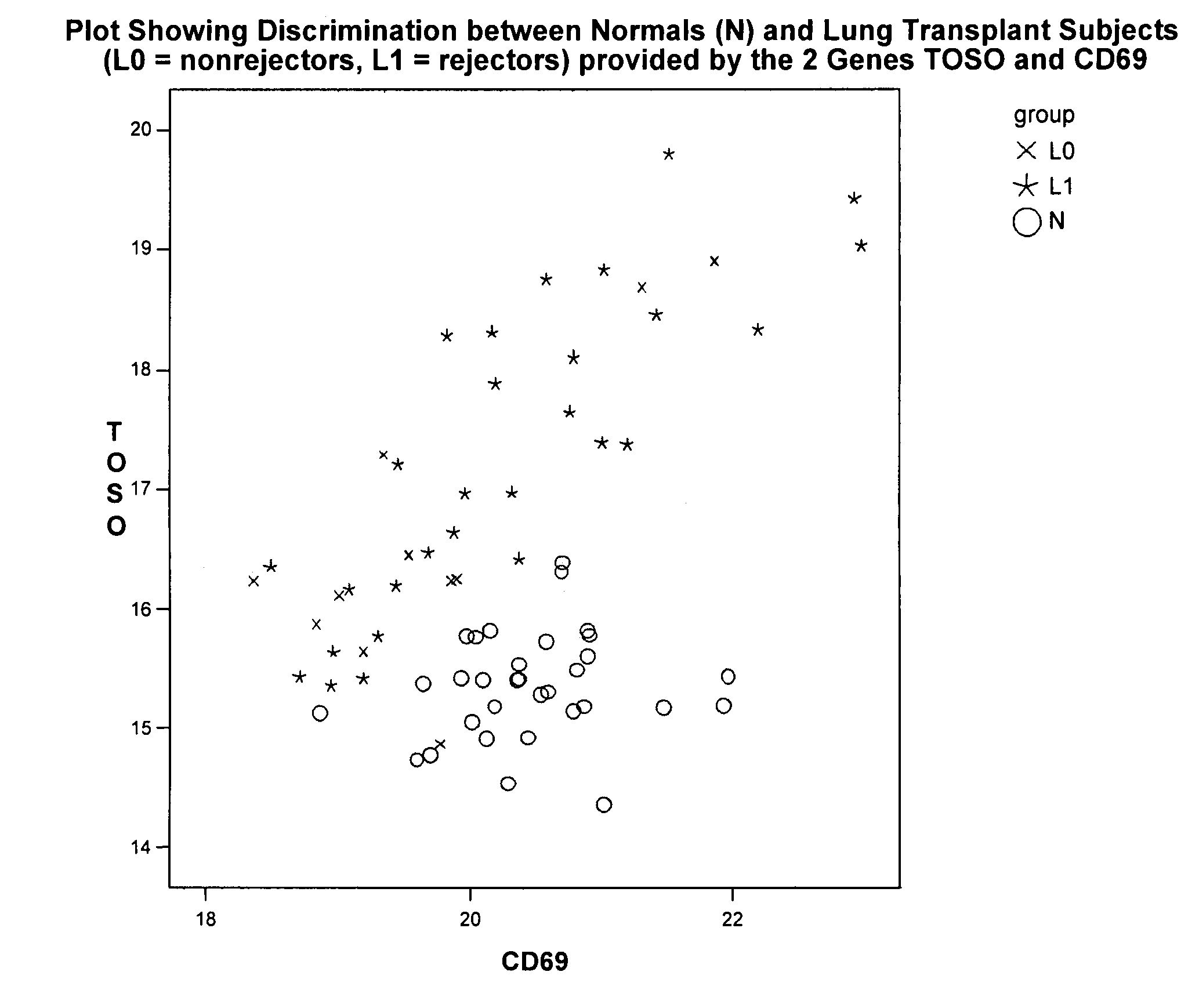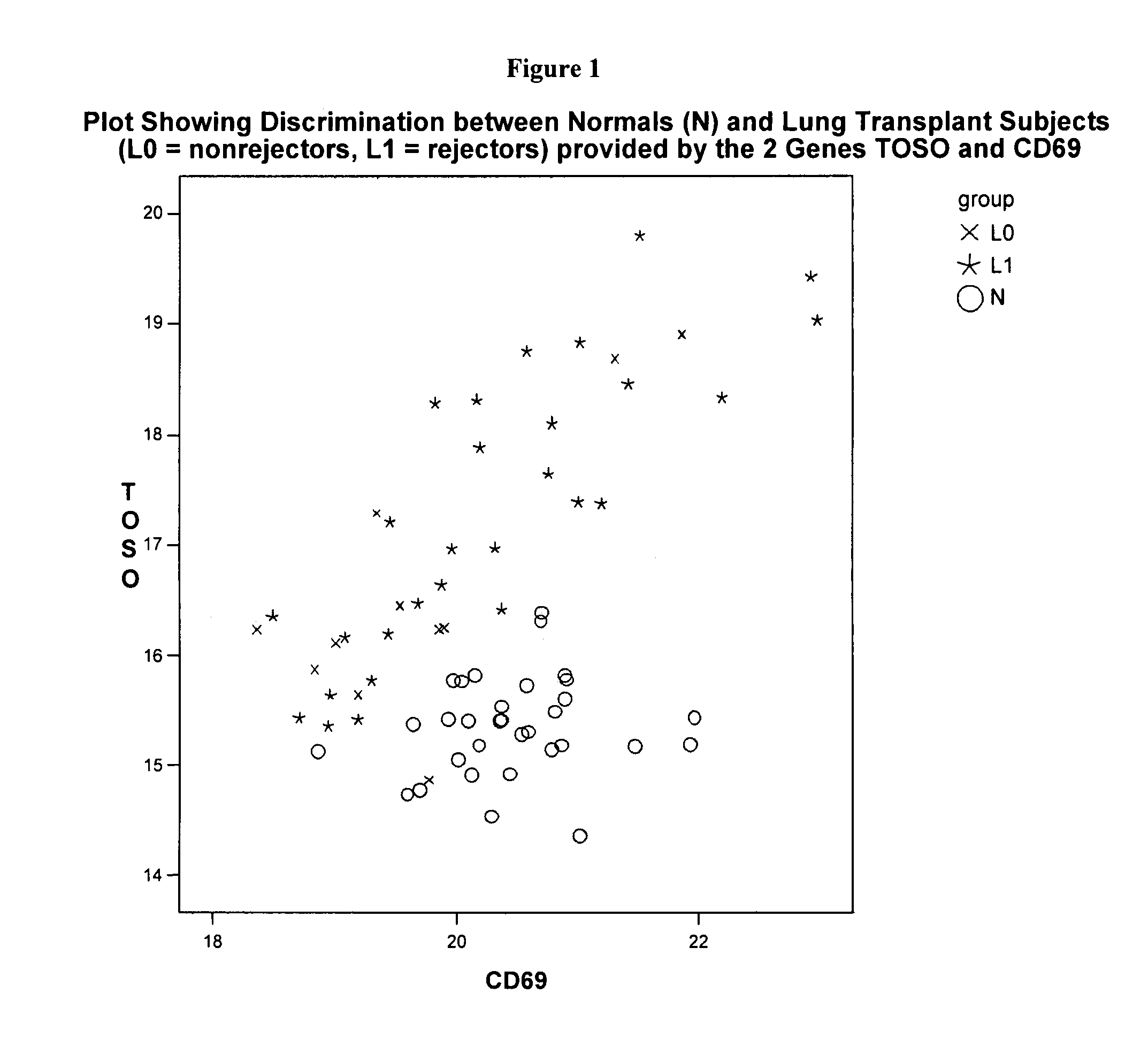Gene expression profiling for identification, monitoring and treatment of transplant rejection
a gene expression and gene technology, applied in the field of gene expression profiling for identification, monitoring and treatment of transplant rejection, can solve the problems of morbidity and mortality, significant organ damage, and significant clinical risks, and carry significant clinical risks and financial costs
- Summary
- Abstract
- Description
- Claims
- Application Information
AI Technical Summary
Benefits of technology
Problems solved by technology
Method used
Image
Examples
example 1
Transplant (TX) Associated Genes
[0237]Table 1 lists 78 genes whose expression may be monitored to determine whether a subject will reject an organ transplant. Table 2 lists genes whose expression may be monitored to determine whether an individual is immunosuppressed or the ability of a candidate compound to suppress the immune system.
TABLE 1Precision Profile ™ for Transplant RejectionGene SymbolGene NameGene Accession NumberAPAF1apoptotic protease activating factor 1NM_013229BAXBCL2-associated X proteinNM_138761BCL2B-cell CLL / lymphoma 2NM_000633C1QAComplement component 1, q subcomponent, alphaNM_015991polypeptideCASP3caspase 3, apoptosis-related cysteine peptidaseNM_004346CCL2chemokine (C-C motif) ligand 2NM_002982CCL4chemokine (C-C motif) ligand 4NM_002984CCL5chemokine (C-C motif) ligand 5NM_002985CCR1chemokine (C-C motif) receptor 1NM_001295CCR3chemokine (C-C motif) receptor 3NM_001837CD14CD14 antigenNM_000591CD19CD19 AntigenNM_001770CD3ZCD3 Antigen, Zeta PolypeptideNM_198053CD4C...
example 2
Determination of Genes Differentially Expressed in Acute Lung Transplant Rejection
[0238]The objective of this study was to ascertain determine gene expression profiles in acute rejection in lung transplant recipients. To do this, several questions need to be answered. These include: 1) Are there characteristic changes in whole blood gene expression that are pathomnemonic for acute rejection that can be detected in patients who are being treated with significant immunosuppressive therapy? 2) What is the time lag between changes in gene expression and the clinical manifestations of rejection? 3) Can a simple, cost-effective test be developed that can identify these changes in time for an intervention to be initiated without having to corroborate the results with invasive diagnostic procedures? The specific aims of the proposed research were to:[0239]1. Measure the expression of 88 inflammation-immune related genes in whole blood from patients who are about to initiate high-dose immuno...
example 3
Clinical Data analyzed with Latent Class Modeling
[0271]Using Source MDx ΔCt measurements on 44 genes that are known to be involved in suppression of the immune system, strong significant differences were detected between 20 lung transplant (LT) subjects and 32 Normals (i.e., individuals not receiving and organ transplant). Since the LT subjects were given a drug to suppress their immune system, this type of difference is not unexpected, but is much less likely to be detected using less precise measurements.
[0272]A stepwise logistic regression was used to evaluate all genes for their ability to discriminate between these 2 groups, separately, as well as in conjunction with other genes. In step 1, the procedure selects the gene that is most significant (lowest p-value) to be the initial gene in the model. In the second step of the procedure, the remaining 43 genes are evaluated to determine their incremental p-values given that the first gene is included in the model. The one that sho...
PUM
| Property | Measurement | Unit |
|---|---|---|
| Fraction | aaaaa | aaaaa |
| Fraction | aaaaa | aaaaa |
| Fraction | aaaaa | aaaaa |
Abstract
Description
Claims
Application Information
 Login to View More
Login to View More - R&D
- Intellectual Property
- Life Sciences
- Materials
- Tech Scout
- Unparalleled Data Quality
- Higher Quality Content
- 60% Fewer Hallucinations
Browse by: Latest US Patents, China's latest patents, Technical Efficacy Thesaurus, Application Domain, Technology Topic, Popular Technical Reports.
© 2025 PatSnap. All rights reserved.Legal|Privacy policy|Modern Slavery Act Transparency Statement|Sitemap|About US| Contact US: help@patsnap.com



